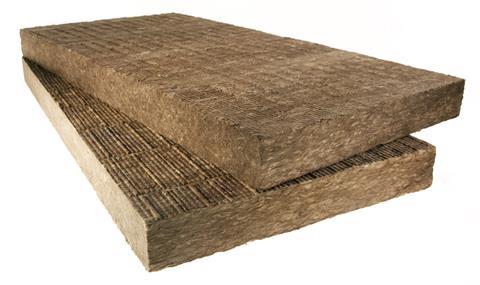When it came to evaluating the thermal performance of the building’s new facade, Knauf Insulation stepped up to the task

The University of Salford’s new Science, Engineering and Environmental (SEE) building features a white rainscreen facade, punctuated by contrasting red window reveals with a sloping sill. While this creates an impactful design statement, it proved challenging to create.
Designed by Sheppard Robson, in conjunction with the university, there was a desire from the outset to specify non-combustible insulation. But the feature red reveal details meant there were restricted cavity widths near the windows, which would affect the depth of insulation that could be installed.
Several mineral wool insulation manufacturers had been unwilling to undertake U-value calculations as it was challenging to understand the weighted U-value across the different facade build-ups and determine the U-value uplift required to compensate for the shallower window reveal areas.
The appointed architect had previously worked with Knauf Insulation and reached out to the specification team to discuss the challenge of developing calculations.
After receiving the plans, Knauf Insulation undertook 3D U-value calculations and confirmed that they could meet the required thermal performance – and crucially it would mean no changes to the design or impact on the cavity widths.

The crucial factor was the type of U-value calculation used. Most manufacturers calculate the U-value for the build-up without the metal substructure, which doesn’t consider the effect of the metal penetration through the insulation. This results in a blanket correction factor being added, leading to the under- or over-specification of insulation.
Either way, it means that the insulation used in the finished project may not deliver the thermal performance that has been specified. In the case of the SEE building, calculating the weighted U-value to prevent this was critical.
Knauf Insulation use numerical modelling (also known as 3D U-value calculations) as standard for all rainscreen facade projects. This methodology thermally models the build-up taking into account the interaction between the insulation and the bars and brackets of the steel framing system (SFS).
As a result, the team say it creates the most accurate available picture of how the build-up will perform thermally after construction.
For the SEE building, several different calculations were undertaken, changing elements of the build-up, including the substructure material and insulation widths, until the optimal combination was determined.

By using this calculation method, the manufacturer was able to meet the brief with a combination of 50mm and 160mm Rocksilk RainScreen Slab, along with 200mm OmniFit Slab 35.
Rocksilk RainScreen Slab is a Rock Mineral Wool slab that is BBA certified for use at any height and has a thermal conductivity of 0.034 W/mK.
OmniFit Slab 35, a Glass Mineral Wool slab with a thermal conductivity of 0.035 W/mK, is ideal for use in the SFS.
Both Rocksilk RainScreen Slab and OmniFit Slab 35 are non-combustible with a Euroclass A1 reaction to fire classification.
Thanks to their sound absorption characteristics, critical for low-mass rainscreen structures, they will help create a quieter environment for the computer and science labs.

Another specification factor that needed careful consideration was sustainability. The building had been designed to minimise its environmental impact in line with the University’s environmental master plan and the specification of glass mineral wool helped the team to achieve this.
The use of renewable energy sources designed into the building, alongside insulation with excellent thermal performance, will help lower the building’s operational carbon. However, it was also important to keep embodied carbon to a minimum.
According to the manufacturer, its glass mineral wool products are manufactured using up to 80% recycled content, including glass collected from the local communities surrounding its factories. The finished products are then compressed by up to 10:1 to fit more product into each lorry, reducing transport-related carbon emissions.
Another creation includes the team’s ECOSE Technology. The bio-based binder contains no added formaldehyde or phenol and is made from natural raw materials that are rapidly renewable and less energy-intensive to manufacture than traditional binders.

Downloads
Knauf Insulation Rocksilk Rainscreen Slab EPD
PDF, Size 1.7 mb















1 Readers' comment